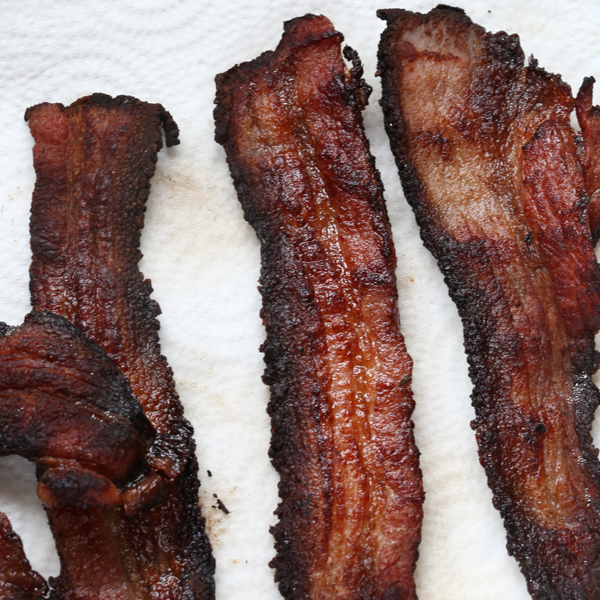
MMM…Bacon…
There are few things in life as splendid as bacon. If your diet allows pork, eating bacon is one of the most primal, aboriginal pleasures a human can enjoy, right up there with sneezing, sex, and laying on the beach, listening to the waves crash.
If you don’t eat pork, I apologize for this post. As a person of faith, I respect your resolve. With all due respect to my church and faith, I also believe in the pure pleasure of eating bacon. Every now and again, I feel the urge to bear witness unto the salty, crispy twigs of mouthwatering, carefully cured pork fat that descend from Heaven and appear on my plate. When I count my blessings, bacon is on the short list.
How lovely that I married a guy that feels the same way about bacon as I do. As we mature and move forward in life, both of us have found that when you love someone or something, it is bountifully rewarding to tweak and improve your relationship with that person or thing. Like bacon, for instance. He now cures his own bacon. Let me tell you, now I love bacon even more. And him too.
Do I love him more because of the home cured bacon? Absolutely.
Home Cured Bacon is Easy to Make
And from what he tells me, it couldn’t be easier. Every month or so he will cure a couple of belly slabs, and stock pile them in the freezer. The slabs don’t last too long. With my homemade bread, homemade mayonnaise (I’m a fervent disciple of bread and mayo too) and his ranch-raised fresh eggs, we feast like a royal couple on the weekends. Although it would mean a smaller portion of bacon, only the presence of our kids at the table can tweak the glory of this breakfast a little higher.
You need to purchase Prague Powder for the cure, which you can find here. And a non-reactive tub or pan for storage during the curing period. Read more about meat curing safety here. You could simply place the pork belly slab in a very large plastic storage bag, but a plastic dish pan or stainless steel tray will be helpful, as bags can puncture, or accidentally leak. Once the pork belly is cured, the slab can be frozen in the same bag.
A helpful hint: the pork belly slab will slice more easily if the slab is still half frozen. I have found by taking the slab out of the freezer and allowing it to thaw for 1 hour will give it the perfect texture for even slicing with a good, sharp knife. I use a very sharp serrated bread knife. If you a home version of a deli-style meat slicers, by all means, put it to work to slice bacon. Much safer by far, and the slices will be more uniform. Or, if you have a butcher friend, maybe they would have a slicer at their shop (Doesn’t everyone have a butcher friend? Pity if you don’t. Get out there and network more.)
Try making home cured bacon. It’s an easy, fun project that will quickly become part of your domestic routine. For as spectacular as bacon can be, home cured is just a little better. Wait a minute: Home cured bacon is a lot better. Imagine if you could improve a day at the beach. Or sneezing? It’s worth your time.
- This beautiful belly is full size, 10 lbs (5kgs) so we are doubling this recipe
- Adding meat cure is vital for food safety, so don’t leave it out!
- Crushing juniper berries in a molcajete
- Dividing our big beautiful belly into two smaller parts for easier handling and packing
- Massaging the cure and spice mix into the pork belly
- Gotta get all those spices and meat cure well massaged into the pork belly!
- Pork belly, massaged and resting in a tub
- Cured Slab of Home Cured Bacon, rinsed of all cure and spices, and packed in a plastic zipper bag
- Home Cured Bacon slices better when partially frozen
- Strips of Home Cured Bacon, ready for the broiler
- Home Cured Bacon, crispy and warm from the broiler.
- Home Cured Bacon, ranch raised eggs fried in bacon drippings, and ranch raised Ruby Red grapefruit
Home Cured Pork Belly for Amazing Bacon
Making home cured pork belly takes a week’s time, but is worth every minute once you take that first bite!
- Prep Time: 1 Week
- Cook Time: 8 mins
- Total Time: 168 hours 8 minutes
- Yield: Makes 5 lbs. 1x
Ingredients
- For every 5lbs pork belly, you will need the following:
- ¼ cup coarse kosher salt
- 2 tsp. Insta-Cure or Prague Powder*
- 4 tbsp. coarsely ground black pepper
- 4 bay leaves, crumbled
- 1 tsp. freshly grated nutmeg
- 1/4 cup brown sugar, honey, or maple syrup
- 5 cloves of garlic, crushed
- 2 tbsp. juniper berries, lightly crushed
- 10 sprigs fresh thyme
Instructions
- Combine the curing ingredients in a bowl, stirring well for even distribution. Place the pork belly in a large non-reactive tub (stainless steel, glass, enamel or plastic – we use a plastic dishpan) Massage the curing ingredients well over both sides of the pork belly. Place the pork belly in a large zipper plastic bag, leaving it well crusted with the curing ingredients. Seal, and place in the refrigerator. Turn the bag over every 48 hours, and leave in the refrigerator for 1 week.
- After 1 week, remove the pork belly from the bag, and rinse away the spices on both sides. Your bacon is ready for slicing.
- A ¼” thick slice should take about 7-8 minutes of cooking time, either under a hot broiler or in a skillet on the stove.

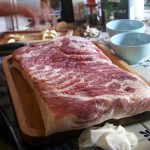
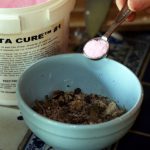
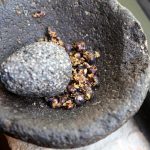
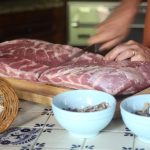
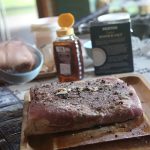
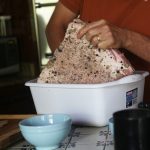
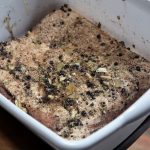
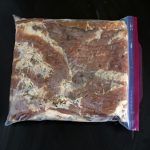
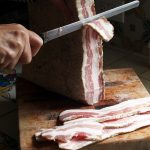

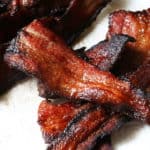

Hi Melissa,
I noticed you do not recommend any time in the oven to finish the process. Is oven time necessary? Other recipes I have looked at all say to put your finished bacon in a slow oven till the internal temp. is 150.
Hi, sure you can do that if you want to fully cook it after you cure it. We keep it in a raw state and then cook it right before we need it. I will go back to my recipe and clarify. Email me back if you like, sorry this took so long for me to respond. I was freaking out over a speaking engagement.
thanks!!
Have you ever used frozen pork belly and thawed it then cured it??
Hi, when I cure pork belly, it is never frozen. Having said that, I think that a lot of the meats they receive at the different supermarkets are received frozen, and then they thaw them out. I think if it has been frozen, it will be fine. We usually get our pork bellys at Costco, and I am pretty sure they receive them frozen, and then thaw for sale. Ours always turn out great! Hope your does too!
MG
Is there any need or advantages to press the seasoned belly with weights while it is curing? This is common when salt curing salmon for gravlax.
Hi Chef! Not that I am aware of. Salmon has a different flesh than pork. Fish are cold blooded, they adjust their body temp to go with the temp of their surroundings. Pork or pigs have a constant temperature that needs to be maintained, so they have layers of fat to keep them warm. I am sure that has something to do with the way their flesh is cured, it depends on the intramuscular or interstitial fat. I suppose fattier meats can dry cure and leaner fish needs wet cure? With the method that we use here at the ranch for making pork belly (bacon) its a dry cure, as opposed to gravlax, which is a wet cure. The short answer is no weights, but I am not 100% clear as to why. Super interesting question! You have piqued my curiousity. I will try to do some research and suss this out. Stay tuned on Instagram or FB to my feed. If I find out why, I will post it. Thanks and stay tuned!
Have you ever smoked it after curing it and if so what wood
Hi, no I haven’t. We use only mesquite wood here at the ranch, but it is a heavy, oily scent. If we tried, I think the process would be quick, as the mesquite smoke is quick to penetrate anything. We haven’t been sucessful with our outdoor smoker. But if I did try it again, it would be with mesquite.
Take the time to find some Maple or apple wood if you’re going to smoke it. Mesquite is too acrid for pork belly IMO.
That is a good point. Mesquite is its own worst enemy. We love it, but it has a really strong personality. Like my relatives.???? Thanks for the note! MG
What does the insta cure do? Is it necessary
Hi, Instacure is a nitrate additive that cures the meat. All processed meats such as bacon and cold cuts use some time of cure. Some people object to cures as they feel they are unhealthy, or affect blood pressure. The plus side of adding Instacure is that there is no chance of botulism spoilage when curing bacon. There are new non-nitrate cures available on the market made with celery seeds, but I don’t have enough info on those, nor know where you can get those for home use. We use it with good results. In fact, home cured bacon is so good that in general we have cut down out processed meat consumption. Commercially processed meats like ham or turkey breast just don’t appeal to us any more. But home cured bacon is amazingly delicious, so we enjoy that instead! Let me know if I can answer any other questions for you!
The whole “celery salt” trend is kind of pointless because from a chemists perspective (my husband) it has the same nitrites. Chemically speaking…its the same exact thing just hidden in the word “celery” for marketing purposes and so they can raise the price and make it sound more natural. And they can say “no nitrites ADDED” because the celery salt is considered a spice.
Hi! Yeah it’s hard to understand the way marketing spin works into some products. Personally, I am anti-botulism, so I am ok with nitrites. People seem to want less processed foods, but they want more food and travel photos that are digitally processed. People pictures too. Go figure.
thanks for your note! Stay healthy!
Do you use the same recipe/directions for pre-sliced pork belly rather than a slab? Slices are roughly 5/16 t hick from Costco. The plan is to leave frozen raw and cook as needed from small vacuum packed packages.
Hi Harold! I would certainly give it a try. Pork belly can be difficult to slice when it is thawed, and dangerous to slice when it is frozen. I think most people make the pork belly with a slab because they like thicker slices than what is available at Costco. That is exactly where my husband buys his pork bellys. Maybe try making a half portion of the rub, for a half sized batch of pork belly using sliced belly. I don’t have a solid answer for this, as I have never tried it. But I would give a half batch a try and see how it goes. Very interested, let me know the results, direct email melissa@melissaguerra.com . thanks for your note!!
Can I used it to make hog cracklins?
Hello Jeffrey! That is a good question! I have tried a few times to make cracklings, and it has been disasterous. So I can’t give you any advice. I wish I could because I love cracklings! When I find out more info, I will post it. Best of luck!! (PS check Pinterest, which is where I find loads of advice on unfamiliar techniques.)
Hola Melissa,
What do you think about adding mace to compliment the nutmeg in the cure?
I’m taking the bacon to the coast for a party. It’s going on eggs Benedict for brunch.
Yum, I emailed you just ansering this late. Let me know how it turned out. xoxo